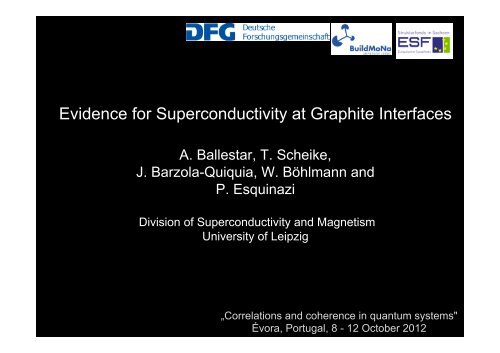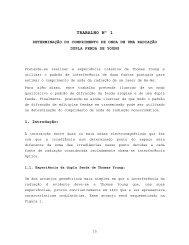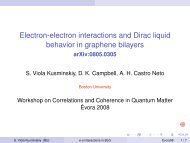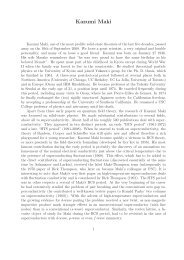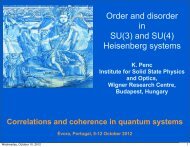Evidence for Superconductivity at Graphite Interfaces
Evidence for Superconductivity at Graphite Interfaces
Evidence for Superconductivity at Graphite Interfaces
You also want an ePaper? Increase the reach of your titles
YUMPU automatically turns print PDFs into web optimized ePapers that Google loves.
<strong>Evidence</strong> <strong>for</strong> <strong>Superconductivity</strong> <strong>at</strong> <strong>Graphite</strong> <strong>Interfaces</strong><br />
A. Ballestar, T. Scheike,<br />
J. Barzola-Quiquia, W. Böhlmann and<br />
P. Esquinazi<br />
Division of <strong>Superconductivity</strong> and Magnetism<br />
University of Leipzig<br />
„Correl<strong>at</strong>ions and coherence in quantum systems"<br />
Évora, Portugal, 8 - 12 October 2012
BASICS I<br />
Main experimental evidence <strong>for</strong> the<br />
phenomenon of superconductivity<br />
• Field expulsion (Meissner st<strong>at</strong>e, perfect<br />
diamagnetism)<br />
• Zero resistance st<strong>at</strong>e<br />
• Existence of vortices or fluxons<br />
• Josephson effect
BASICS II<br />
Granular superconductivity<br />
Microscopic superconducting grains in a non-superconducting m<strong>at</strong>rix<br />
• Josephson tunnelling between the grains influences the<br />
I-V curves, R à zero <strong>at</strong> low T and I (current). Barzola et al.,<br />
“Graphene” (2011). Ballestar et al., arXiv/1206.2463<br />
• Anomalous thermally activ<strong>at</strong>ed-like temper<strong>at</strong>ure dependence<br />
of the resistance, R ~ e -T 1 /T . García et al., NJP 14, 053015 (2012)<br />
• Andreev sc<strong>at</strong>tering: peculiarities in the I/V curves or periodic<br />
oscill<strong>at</strong>ions of the magnetoresistance. Esquinazi et al., Phys. Rev. B 78,<br />
134516 (2008)<br />
• Anomalous field hysteresis loops of the magnetoresistance.<br />
Esquinazi et al., Phys. Rev. B 78, 134516 (2008), Dusari et al., J Supercond Nov Magn 24, 401405 (2011)<br />
• Anomalous field hysteresis loops of the magnetiz<strong>at</strong>ion. Scheike et<br />
al, Adv.M<strong>at</strong>. Suppl Inf. (2012) and to be published.<br />
All these phenomena were observed recently in graphite samples
From all the evidence obtained in the last 38 years on high-<br />
T c granular superconductivity in graphite<br />
I restrict to the following observ<strong>at</strong>ions<br />
• (1) Giant field driven Metal-Insul<strong>at</strong>or transition in bulk ordered<br />
graphite samples (2001-2011) à An effect due to internal interfaces<br />
• (2) Zero-resistance st<strong>at</strong>e due to Josephson coupled<br />
superconducting p<strong>at</strong>ches <strong>at</strong> internal interfaces in ordered graphite:<br />
measurements of lamellae (2009-2012)<br />
• Anomalous field hysteresis in the magnetoresistance of thin graphite<br />
samples (2008-2011)<br />
• Quantum resonances assigned to Andreev reflections in the<br />
magnetoresistance (2008)<br />
• Electric field induced resistance transition in thin graphene samples<br />
(2012)<br />
• (3) Granular superconductivity in w<strong>at</strong>er-tre<strong>at</strong>ed graphite powder<br />
(2012) à Magnetiz<strong>at</strong>ion measurements
Theoretical work 2001-2012 on possible superconductivity<br />
in graphite/graphene<br />
– SC predicted in inhomogeneous regions of graphite structure [1]<br />
– RVB <strong>Superconductivity</strong> [2,7]<br />
– SC possible if the carrier density n>10 13 cm -2 [3]-[6]-[10]<br />
– High-Tc surface superconductivity in topological fl<strong>at</strong>-band systems [8]<br />
[1] J. Gonzalez, M. Vozmediano, F. Guinea, Phys. Rev. B, 63, 134421 (2001)<br />
[2] G. Baskaran, Phys. Rev. B 65, 212505 (2002)<br />
[3] A. M. Black-Schaffer and S. Doniach, Phys. Rev. B, 75, 134512 (2007)<br />
[4] N. Garcia and P. Esquinazi, J. Supercond. Nov. Magn., 22, 439 (2009): “2D <strong>Superconductivity</strong>”<br />
[5] B. Uchoa and A.H.C. Neto, Phys. Rev. Lett., 98, 146801 (2007)<br />
[6] N.B. Kopnin and E.B. Sonin, Phys. Rev. Lett., 100, 246808 (2008)<br />
[7] S. P<strong>at</strong>hak, V. Shenoy and G. Baskaran, Phys. Rev. B 81, 085431 (2010): “d+id pairing”<br />
[8] Savini et al., PRL 105, 037002 (2010): Doped graphane as a high-temper<strong>at</strong>ure electron-<br />
phonon superconductor.<br />
[9] N. B. Kopnin, T. T. Heikkilä, and G. E. Volovik, Phys. Rev. B 83, 220503(R) (2011)<br />
[10] R. Nandkishore et al., N<strong>at</strong>ure Physics 8, 158 (2012): „Chiral d-wave superconductivity“<br />
[11] G. Profeta et al., N<strong>at</strong>ure Physics 8, 131 (2012): „e-ph coupling and Li ad<strong>at</strong>oms“<br />
[12] Hosseini and Sareyan, Phys. Rev. Lett. 108, 147001 (2012): “Exotic Chiral Superconducting<br />
Phase in a Graphene Bilayer”<br />
and continues …
Further experimental evidence <strong>for</strong> granular<br />
superconductivity in doped graphite or disordered<br />
carbon<br />
(other papers in liter<strong>at</strong>ure)<br />
• K.Antonowicz, Possible superconductivity <strong>at</strong> room temper<strong>at</strong>ure, N<strong>at</strong>ure 247,<br />
358 (1974)<br />
• I. Felner and Y. Kopelevich, Magnetiz<strong>at</strong>ion measurement of a possible hightemper<strong>at</strong>ure<br />
superconducting st<strong>at</strong>e in amorphous carbon doped with sulfur.<br />
Phys. Rev. B 79, 233409 (2009) .<br />
• R. Ricardo da Silva, J. H. S. Torres, and Y. Kopelevich, Indic<strong>at</strong>ion of<br />
superconductivity <strong>at</strong> 35 k in graphite-sulfur composites. Phys. Rev. Lett. 87,<br />
147001 (2001).<br />
• H.-P. Yang, H.-H. Wen, Z.-W. Zhao, and S.-L. Li. Possible superconductivity<br />
<strong>at</strong> 37 k in graphite-sulfur composites, Chin. Phys. Lett. 18, 1648 (2001).<br />
• S. Moehlecke, P. C. Ho, and M. B. Maple. Coexistence of superconductivity<br />
and ferromagnetism in the graphite sulphur system. Phil. Mag. B 82, 1335<br />
(2002).
(1)<br />
Giant „Metal-Insul<strong>at</strong>or Transition“ in<br />
BULK graphite <strong>for</strong> fields perpendicular<br />
to graphene planes<br />
This MIT is NOT intrinsic of<br />
the graphite structure but it<br />
vanishes <strong>for</strong> thin samples<br />
Y. Kopelevich, P. Esquinazi, J. Torres, R. da Silva and H. Kempa,<br />
Adv. Solid St<strong>at</strong>e Physics 43, 207 (2003)
The metallic-like properties and the MIT are<br />
Resistivity grows the<br />
thinner the graphite<br />
sample<br />
NOT intrinsic of ideal graphite<br />
The metallic behavior of R(T)<br />
changes to semiconducting the<br />
thinner the sample<br />
bulk<br />
< 70 nm thick<br />
J. Barzola-Quiquia, et al., phys. st<strong>at</strong>. sol. (a) 205, 2924 (2008)
Internal Structure of oriented pyrolytic graphite measured<br />
with TEM 18keV<br />
c-axis<br />
400nm<br />
The picture indic<strong>at</strong>es the existence<br />
of ~ 30…150nm thick (c-axis<br />
direction) crystalline regions<br />
separ<strong>at</strong>ed by 2D-interfaces<br />
J. Barzola-Quiquia, et al., phys. st<strong>at</strong>. sol. (a) 205, 2924 (2008)<br />
N. García et al., New Journal of Physics 14 (2012) 053015
BUT<br />
2D-interfaces in some solids show<br />
SUPERCONDUCTIVITY
<strong>Superconductivity</strong> <strong>at</strong> the interfaces between two<br />
crystalline regions of Bi or BiSb<br />
F. M. Muntyanu et al., Solid St<strong>at</strong>e Commun. 147, 183 (2008)<br />
T c ~ 21 K<br />
Bi
Gozar Gozar et et al., al., N<strong>at</strong>ure N<strong>at</strong>ure 455, 455, 782 782 (2008) (2008)<br />
High-Temper<strong>at</strong>ure<br />
interface<br />
<strong>Superconductivity</strong><br />
between metallic<br />
and insul<strong>at</strong>ing<br />
copper oxides
The temper<strong>at</strong>ure dependence of the resistance in bulk<br />
graphite ordered samples can be understood under the<br />
following basic assumptions<br />
(1) Metallic-like behavior in the resistivity is not<br />
intrinsic but mainly due to the parallel<br />
contribution from internal interfaces<br />
(2) Non-percol<strong>at</strong>ive superconducting regions,<br />
„granular superconductivity“, are loc<strong>at</strong>ed <strong>at</strong><br />
the interfaces, i.e. <strong>at</strong> regions with high carrier<br />
density.
e -T 1 /T<br />
20µm thick<br />
20 nm<br />
e -T 1 /T<br />
37 nm<br />
e +E g /2T<br />
N. García et al., New Journal of Physics 14 (2012) 053015<br />
50 nm thick
Behavior similar to the superconductingsemiconducting<br />
transition in granular Al-Ge<br />
Shapira and Deutscher, PRB 27, 4463 (1983)<br />
J. S. Langer and V. Ambegaokar, Phys. Rev. 164, 498(1967)<br />
D. E. McCumber and B. I. Halperin, Phys. Rev. B1, 1054 (1970)<br />
-T 1/T<br />
e
Magnetiz<strong>at</strong>ion measurements of bulk HOPG<br />
samples <strong>for</strong> fields normal to the internal<br />
interfaces<br />
T. Scheike, P. Esquinazi, to be published
(2)<br />
<strong>Evidence</strong> <strong>for</strong> Josephson<br />
coupled superconducting<br />
regions <strong>at</strong> the internal 2D<br />
interfaces in well ordered<br />
graphite samples
Bulk graphite<br />
c axis<br />
≈15µm<br />
Lamella prepar<strong>at</strong>ion<br />
≈ 1 µm<br />
≈7µm<br />
≈200nm<br />
30…100nm<br />
c axis<br />
Superconducting<br />
p<strong>at</strong>ches<br />
Lamella<br />
Josephson coupling?<br />
Graphene<br />
c axis<br />
≈1nm<br />
≈200nm<br />
J. Barzola, A. Ballestar, S. Dusari and P.E., Chapter 8 in Graphene (2011)
Lamella<br />
A. Ballestar, J. Barzola-Quiquia and P.E., arXiv/1206.2463
Temper<strong>at</strong>ure dependence of the voltage <strong>at</strong><br />
constant current <strong>for</strong> different lamellae<br />
A. Ballestar, J. Barzola-Quiquia and P.E., arXiv/1206.2463
- Clear current dependence of the resistance à typical <strong>for</strong> granular superconductivity<br />
- Josephson-like I/V characteristics<br />
A. Ballestar, J. Barzola-Quiquia and P.E., arXiv/1206.2463
(3) Granular superconductivity in w<strong>at</strong>ertre<strong>at</strong>ed<br />
graphite powder<br />
- “Doping” through w<strong>at</strong>er ?<br />
- Effects of w<strong>at</strong>er to the “hydrophobic” n<strong>at</strong>ure<br />
of a graphite surface is non-trivial<br />
• K. Suzuki et al., Applied Physics Express 4, 125102 (2011):<br />
Existence of a uni<strong>for</strong>m structured-w<strong>at</strong>er layer <strong>at</strong> the graphite/w<strong>at</strong>er<br />
interface<br />
• Several papers report on the existence of different kinds of gas<br />
bubbles <strong>at</strong> the graphite surface in w<strong>at</strong>er: Zhang et al., Langmuir 25,<br />
8860 (2009)<br />
• Understanding controls on interfacial wetting <strong>at</strong> epitaxial graphene:<br />
Experiment and theory: Zhou et al., Phys. Rev. B 85, 035406 (2012)
Prepar<strong>at</strong>ion<br />
• 100 mg ultra pure graphite powder was<br />
mixed into 20 mL distilled w<strong>at</strong>er and this<br />
mixture is continuously stirred <strong>at</strong> room<br />
temper<strong>at</strong>ure <strong>for</strong> one day<br />
• Powder recovered by filtr<strong>at</strong>ion<br />
• dried <strong>at</strong> 100 o C overnight<br />
• packed in polymer foils of less than 1 mg<br />
mass
W<strong>at</strong>er-tre<strong>at</strong>ed graphite powder
ZFC-FC Hysteresis in<br />
w<strong>at</strong>er-tre<strong>at</strong>ed graphite powder<br />
<strong>Evidence</strong> <strong>for</strong> pinning of magnetic entities<br />
T. Scheike, W. Böhlmann, P. E., J. Barzola-Quiquia, A. Ballestar<br />
and A. Setzer, Adv. M<strong>at</strong>. (2012)
Low-field hysteresis in granular superconductors<br />
See <strong>for</strong> example: Senoussi et al,<br />
YBaCuO pellet
w<br />
w
The T-dependence of the Josephson critical fields<br />
J<br />
J
Low field Hysteresis in w<strong>at</strong>er-tre<strong>at</strong>ed<br />
graphite powder<br />
T. Scheike, W. Böhlmann, P. E., J. Barzola-Quiquia, A. Ballestar and A. Setzer<br />
Adv. M<strong>at</strong>. (2012)<br />
h c2 J<br />
h c1 J
Full remanence width of magnetiz<strong>at</strong>ion vs.<br />
maximum applied field
Remanent magnetiz<strong>at</strong>ion,<br />
lower critical fields and<br />
surface barriers in an<br />
YBa 2 Cu 3 0 7 crystal<br />
M.W. Mcelfresh,<br />
Y. Yeshurun,<br />
A. R. Malozemoff, and<br />
F. Holtzberg<br />
Physica A 168 (1990)<br />
308-318
Time dependence of the magnetiz<strong>at</strong>ion: flux creep
Flux creep in RTS graphite powder<br />
T. Scheike, W. Böhlmann, P. E., J. Barzola-Quiquia, A. Ballestar and A. Setzer<br />
Adv. M<strong>at</strong>. (2012)
38 years of specul<strong>at</strong>ions on the existence of hightemper<strong>at</strong>ure<br />
superconductivity in graphite<br />
• Anomalous temper<strong>at</strong>ure dependence of the resistivity of bulk<br />
HOPG of high quality <strong>at</strong> zero field<br />
• Giant field-induced Metal-Insul<strong>at</strong>or Transition<br />
• Anomalous, superconducting-like hysteresis loops in SQUID<br />
measurements<br />
• Anomalous hysteresis loops and “Andreev-like” quantum<br />
oscill<strong>at</strong>ions in the magnetoresistance of thin graphite flakes<br />
• Resistivity increases the thinner the sample à TEM evidence <strong>for</strong><br />
the influence of interfaces<br />
• Field-induced transition in the resistance near an interface<br />
• Josephson-like IV curves in specially prepared lamellae<br />
• <strong>Evidence</strong> <strong>for</strong> granular superconductivity above 300K in the<br />
hysteresis loops, ZFC-FC and flux creep experiments of specially<br />
prepared graphite powders
Open questions and experimental tasks <strong>for</strong> the future<br />
ü <strong>Evidence</strong> indic<strong>at</strong>es th<strong>at</strong> interfaces play a role, but is<br />
there a especial “misalignment angle” or stacking<br />
fault?<br />
ü Is it enough a bilayer or the Bernal multigraphene<br />
structure <strong>at</strong> both sides is necessary?<br />
ü Is it simply due to an increase of the carrier<br />
concentr<strong>at</strong>ion, or special defects and/or hydrogen<br />
play a role?<br />
ü Is there a single superconducting phase? Which?<br />
ü How to produce it in large enough amount?<br />
ü Is magnetic order playing some role in it?<br />
ü Basic parameters remain unknown like T c , H c1 , H c2 ,<br />
etc. ….<br />
ü ….


